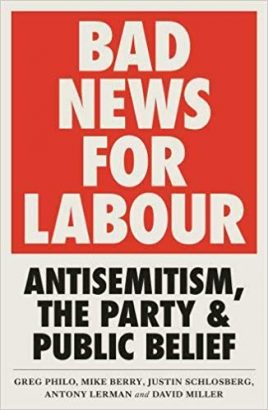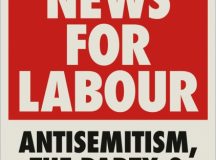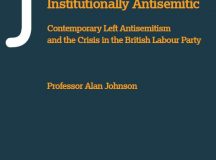Bad News for Labour: Antisemitism, The Party & Public Belief sets out to reveal ‘the reality behind the headlines’, countering what it claims are overblown and distorted accounts of Labour’s antisemitism problem in the media. It strives for a tone of objective neutrality, of ‘rigorous analysis’ to quote the cover blurb – yet its far from neutral stance is betrayed, in particular, by the many significant gaps and omissions in its argument.
The first chapter, co-authored by Greg Philo and Mike Berry, describes research carried out into public perceptions of antisemitism in the Labour Party, drawing on both opinion polls and focus groups. The authors note a striking disparity between the percentage of Labour members actually reported for antisemitism, and answers given by members of the public when faced with this question:
What percentage of Labour Party members do you think have had complaints made about them for antisemitism?
The results surprised us since the answers ranged from 25-40 per cent of members. (p.2)
Although it seems possible that people might have estimated a lower figure if the question had been framed just a little more precisely – specifying official, formal complaints – this is still a huge and noteworthy gap. The authors are understandably keen to produce this as their ‘gotcha’ moment, as proof that the problem has been given undue emphasis by the media.
However they fail to offer vital contextual information that is needed if one is to fully understand the problem, and how it should be measured. Although the individual instances of antisemitism – those formal complaints – are of course significant, what is still more important is the relationship between these cases and the institutional culture and apparatus of the Labour Party. In many cases, for example, a single antisemitic remark has apparently gone unremarked by dozens of activists who are thus made complicit in the problem. And there is no real analysis, either in this chapter or in the book as a whole, of the troubled history of antisemitism on the left, a topic Dave Rich and others have analysed in depth. That would have helped readers understand why some Corbyn supporters might be vulnerable to conspiratorial rants about Rothschild bankers such as the piece shared back in 2011 by Salma Yaqoob, currently a prospective Labour mayoral candidate in the West Midlands.
But perhaps the most egregious omission is any sustained engagement with Jeremy Corbyn’s own chequered track record on antisemitism. How can a book dedicated to antisemitism in the Labour Party contain no references to Paul Eisen – to Raed Salah – to Stephen Sizer? Again and again I found myself looking up key players in the index – and finding nothing. The wreath-laying controversy is discussed, but only in order to claim (not very convincingly) that it had been exaggerated (p.10). We are repeatedly told that many complaints are motivated by hostility to Jeremy Corbyn – which amounts to asserting bad faith. What the authors fail to acknowledge is that a good deal of hostility to Corbyn was originally sparked by his own dubious statements and connections. There’s a reason why, although the right wing press was also pretty hostile to Michael Foot, they did not associate him with antisemitism.
There’s a telling moment in that first chapter when Philo and Berry offer a brief list of headings for their focus group discussions:
- Reasons for higher estimates and influences on decisions made about these.
- Reasons to doubt the story and give lower estimates.
- Beliefs about the impacts of the story on perception of the Party and voting. (p. 7, Italics mine)
This elision between doubting the ‘story’ as a whole and giving lower, more accurate, estimates for complaints is tendentious. People often overestimate all kinds of figures in polls – the numbers of Muslims in the UK, for example, or the amount of money spent on foreign aid. Official complaints about members represent just one aspect of Labour’s antisemitism problem and the authors largely avoid dealing with its toxic complexities directly, choosing instead to skitter around its margins.
‘Divisions and Competing Accounts’, the book’s second chapter, also co-authored by Philo and Berry, is concerned with debating the extent and nature of antisemitism in the Labour Party. Even though the authors of course want to downplay the problem, there are some revealing moments here, such as this testimony from a party activist:
The frequency with which I now see antisemitism online from people purporting to be on the left is a genuine cause of concern. Admittedly, much of it is undoubtedly a reaction to the way this has been weaponized to bash Corbyn, is almost always to do with Israel and the vast majority of it is down to naivety as opposed to any conscious hostility towards Jews, but it’s concerning nonetheless. (p. 25)
Would the activist respond in this way when reflecting on allegations concerning any other form of racism? It seems unlikely, faced with concerns relating to a different minority, that they would feel this urge to contextualise racism, to ‘understand’ it, to absolve its perpetrators of conscious malice. And if this were the subject under investigation would Philo and Berry really think it adequate or meaningful to offer a series of testimonials by white people affirming that they’d never – well hardly ever – seen any racism themselves?
Philo and Berry then turn to the hotly contested issue of definitions of antisemitism, in particular that proposed by the International Holocaust Memorial Alliance (IHRA). This is a complex area, but in their critique of the way recent definitions have highlighted anti-Israel discourse as a vector for antisemitism the authors skate over the reasons why Jewish (like Kurdish) self-determination is such a charged issue, or the ways in which ‘criticism of Israel’ may draw on antisemitic tropes of Jewish control, or becomes enmired in Holocaust inversion. They also amplify extreme and uncharacteristic interpretations of the IHRC definition in order to discredit it. This commentary by Nathan Thrall, for example, is quoted unchallenged.
By the state department’s definition, delegitimisation includes ‘Denying the Jewish people their right to self-determination, and denying Israel the right to exist’. Thus anti-Zionism – including the view that Israel should be a state of all its citizens, with equal rights for Jews and non-Jews – is a form of delegitimisation and therefore antisemitic. (p. 42)
Philo and Berry gloss this account approvingly, ‘the term self-determination has been interpreted in the application of the new definition, such that even asking for equal rights would now be termed antisemitic.’ (p. 42) The possibility that the IHRA definition – and other definitions of racism and bigotry – might be invoked inappropriately certainly cannot be ruled out completely. It is a tool to aid people trying to combat racism in good faith and not some kind of foolproof litmus test. In David Miller’s own brief contribution to this volume, ‘“A” State of Israel’ or “The” State of Israel: The Politics of the IHRA Definition’ (Chapter Six) he argues that the definition is capacious enough to allow him to speak freely about his own views regarding Israel’s creation. Although I don’t agree with Miller’s description of Israel as a settler-colonial project it is certainly true that there are racist elements in the histories of many states and to discuss any such issues in the case of Israel is not – or need not be – antisemitic.[i]
In Chapter Three, snappily titled ‘What Could Have Been Done and Why it Wasn’t, and Will it End?’, Berry and Philo turn to errors in the Labour Party’s handling of the crisis, in particular the way it has dealt with complaints. The authors insist that the main problem lay with the Labour Party’s bureaucracy, that media reports of neglect and delay were unfair, and that emails had been selectively leaked to imply improper interference from the LOTO’s office (p. 49). This is a really knotty topic and it’s difficult to adjudicate between different versions of events when so much relevant information simply isn’t, or isn’t yet, available. But again, what shines through is the authors’ partisan and tendentious approach to the issue.
I’ll highlight three small details from a single page (p. 65) to give some indication of the problem. We are told that the issue may subside ‘if the intention is to reduce antisemitism in the traditional sense of an irrational hatred of Jewish people [.]’ This is setting the bar high. Racism (particularly institutional racism) is not dependent upon hatred, and can be the result of unconscious, implicit bias. This laudable intention – stopping hatred of Jews – is then contrasted with various possible bad motives for making a fuss. One of these is wanting to ‘displace Jeremy Corbyn because of the internal politics of the Party’. The implication seems to be that people are weaponising antisemitism charges because they are secretly worried about rail nationalisation or the prospect of repealing anti-union legislation. But what if one sees Jeremy Corbyn as inextricably connected to the issue of antisemitism? Here’s another (bad) motive adduced by the authors:
[The problem] will continue if the intention is to reshape the definition and understanding of antisemitism to argue that movements such as BDS and contemporary criticisms of Israel are illegitimate. (p. 65)
There are different views about the precise relationship between BDS and antisemitism, but no one is seeking to argue that mere ‘criticisms of Israel’ are illegitimate – and if the authors in fact meant ‘criticisms of Israel’s right to exist’ then they should have said so.
Justin Schlosberg’s chapter deals with ‘Media Coverage of the IHRA Definition and its Adoption by the Labour Party.’ It asserts that coverage of this issue was biased in overstating the IHRA definition’s acceptance worldwide, and treating its supporters indulgently while largely ignoring the views of those with strong reservations. Again, it’s difficult to unpick a narrative or argument based on just a few elements of a complex weave without replicating the original research. However the very first detail I investigated offers a good indication of some of the problems with this chapter. Schlosberg argues that the media unfairly accused the Labour Party of not consulting with appropriate communal organisations when drawing up their new disciplinary code of conduct in 2018. He asserts, in support of this claim, that Ivor Caplin, the then co-chair of the Jewish Labour Movement, made some positive comments following discussions with Jennie Formby. Caplin’s indications that these talks were encouraging, Schlosberg argues, suggest that reports of a failure to engage with the Jewish community were misleading. However an article published in the Jewish Chronicle on 4 July 2018 reveals that Ivor Caplin’s statement was in fact highly controversial – an outlier within this whole series of events. It was felt he had been ill-prepared for the meeting and had been ‘played’. Schlosberg was evidently aware of this important context as he quotes from the very same article (p. 90). The fact that he omits any mention of the controversy suggests that his analysis is highly selective.
Chapter Five, Anthony Lerman’s ‘Weapons in the Labour Antisemitism Wars?’, returns to debates over the IHRA definition. The precise relationship between anti-Zionism and antisemitism (and between BDS and antisemitism) is of course both complex and contested. I agree with Lerman that definitions are not sacred texts and shouldn’t be beyond discussion or criticism. But what really concerns me is the way in which commentators such as the authors of this book seem happy to overlook or underplay unambiguous examples of antisemitism. Lerman quibbles about whether the Macpherson definition of institutional racism can apply to Labour because there is no ‘clear distinction between service providers and customers.’ (p. 144) Does this mean that it is similarly categorically impossible for the Tory party to be institutionally Islamophobic? It should only take a little thought and creativity to map the rather different model of a service provider (such as the police force) on to a political party, and establish some workable criteria for establishing whether there is an institutional problem in the Labour Party.[ii]
There’s an interesting undercurrent of anxiety in Lerman’s chapter, as though expectations around the current EHRC investigation into the Labour Party are being carefully managed. Lerman suggests that the EHRC is not a neutral player because its CEO, Rebecca Hilsenrath, has already expressed some concerns about Labour antisemitism, declaring in 2017 that:
Antisemitism is racism and the Labour Party needs to do more to establish that it is not a racist Party. A zero-tolerance approach to antisemitism should mean just that. (p. 155)
Her statement is in fact quite mild, and congruent with the rhetoric which you get from senior figures in Labour such as John McDonnell. Lerman’s contention that Hilsenrath is not neutral might be countered by asking whether Shami Chakrabarti was a fully appropriate person to lead the investigation of Labour’s antisemitism problem given her own burgeoning relationship with the Party and speedy promotion to the House of Lords.
In the conclusion – no author is specified – it is asserted that Richard Burgon had no case to answer when he stated that ‘The enemy of the Palestinian people is not the Jewish people. The enemy of the Palestinian people are Zionists, and Zionism is the enemy of peace and the enemy of the Palestinian people’ (p. 175). It goes on to argue eloquently that the real enemies are far-right racists, and it is undeniable that the far right are a threat to Jews, Muslims, Roma and many more in this country and elsewhere. However, given that a sizeable proportion of Jews – in Britain and worldwide – will identify as Zionists, including many who strongly oppose Netanyahu’s government, how is it helpful to defend Burgon straying into the language of existential evil when he declared that ‘Zionism is the enemy of peace’?
Although the authors of Bad News For Labour do of course condemn antisemitism, and acknowledge some problems in the Labour Party, they do so in a spirit of bloodless compliance, as though doing just enough to ward off a charge of indifference. The authors also gloss over how very many high profile activists have been involved in the controversy. It’s not only random members and supporters who have spouted unsavoury views. The Stop the War Coalition (of which Corbyn was Chair for many years) is invoked as a perceived problem, but the reader is given no clue as to exactly why the former Board of Deputies President Jonathan Arkush was upset by Corbyn’s involvement with the group or its ‘anti-Israel discourse’ (p. 32). We learn nothing about the blood libellous characterisation of Israel as ‘Moloch, eater of children’ in a poem by Heathcote Williams, or the trivialisation of the Munich Olympic massacre by notorious antisemite Alison Weir, for example. I’ve already mentioned some omissions from the index relating to Corbyn’s past dubious associates. Within the Labour Party itself notable gaps in coverage include Chris Williamson, glancingly mentioned but with no reference to his suspension, and Pete Willsman, the NEC member currently suspended by the party, who isn’t mentioned once, even in the ‘timeline of events’ included as an appendix. Why might this be? The contributors to this volume make much of the possible political motives people may have to maximise Labour’s problems, but fail to explore whether different people may have their own reasons for minimising the issue.
[i] See Ross Clark, ‘It isn’t anti-Semitic to say the creation of Israel was a mistake’, Spectator, 23.7.18 for a discussion of this controversy.
[ii] See for example Alan Johnson’s 2019 Fathom report, Institutionally Antisemitic: Contemporary Left Antisemitism and the Crisis in the British Labour Party, pp. 51-73.


































“it is undeniable that the far right are a threat to Jews, Muslims, Roma and many more in this country and elsewhere. ”
It is very deniable. The far right in this country are a handful of mouthy powerless twats on the internet. The anti-semitic left in this country may be forming a government in six weeks time.